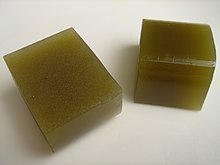Yōkan: Difference between revisions
No edit summary |
|||
| Line 23: | Line 23: | ||
Although most yōkan found in [[Japan]] and abroad are typically made with [[red bean paste]], yōkan made from {{nihongo|white kidney bean paste|しろあん, 白餡|shiro an}} are also relatively common. This type of yōkan is milky and translucent with a much milder flavour than that made of red bean paste. As such, they can be effectively flavoured and coloured by using [[matcha|green tea powder]]. |
Although most yōkan found in [[Japan]] and abroad are typically made with [[red bean paste]], yōkan made from {{nihongo|white kidney bean paste|しろあん, 白餡|shiro an}} are also relatively common. This type of yōkan is milky and translucent with a much milder flavour than that made of red bean paste. As such, they can be effectively flavoured and coloured by using [[matcha|green tea powder]]. |
||
Yōkan may also contain chopped [[chestnut]]s,<ref>[http://wenwen.soso.com/z/q65283598.htm 栗子羊羹] at 搜搜问问 wenwen.soso.com in Chinese</ref> [[persimmon]]s, whole sweetened [[azuki bean]]s, [[ficus|fig]]s, and [[sweet potato]], among other additions. Sugar can also be replaced with [[honey]], dark [[brown sugar]], or [[molasses]] to alter the taste of the yōkan produced. There is also ''shio yōkan'', which uses small amounts of [[salt]] |
Yōkan may also contain chopped [[chestnut]]s,<ref>[http://wenwen.soso.com/z/q65283598.htm 栗子羊羹] at 搜搜问问 wenwen.soso.com in Chinese</ref> [[persimmon]]s, whole sweetened [[azuki bean]]s, [[ficus|fig]]s, and [[sweet potato]], among other additions. Sugar can also be replaced with [[honey]], dark [[brown sugar]], or [[molasses]] to alter the taste of the yōkan produced. There is also ''shio yōkan'', which uses small amounts of [[salt]]. |
||
==History== |
==History== |
||
Revision as of 00:29, 26 July 2014
 | |
| Type | Wagashi |
|---|---|
| Place of origin | Japan |
| Main ingredients | Agar, sugar, red bean paste or white kidney bean paste |

Yōkan (羊羹) is a thick, jellied dessert made of red bean paste, agar, and sugar. It is usually sold in a block form, and eaten in slices. There are two main types: neri yōkan and mizu yōkan. "Mizu" means "water", and indicates that it is made with more water than usual. Mizu yōkan is often chilled and eaten in summer.
Types
Although most yōkan found in Japan and abroad are typically made with red bean paste, yōkan made from white kidney bean paste (しろあん, 白餡, shiro an) are also relatively common. This type of yōkan is milky and translucent with a much milder flavour than that made of red bean paste. As such, they can be effectively flavoured and coloured by using green tea powder.
Yōkan may also contain chopped chestnuts,[1] persimmons, whole sweetened azuki beans, figs, and sweet potato, among other additions. Sugar can also be replaced with honey, dark brown sugar, or molasses to alter the taste of the yōkan produced. There is also shio yōkan, which uses small amounts of salt.
History
Originally a Chinese confection or snack made from gelatin from boiled sheep; the term is literally “sheep geng” (羊 sheep + 羹 thick soup). It was introduced to Japan by Zen Buddhists in the Kamakura and Muromachi periods, around 1191A.D. As Buddhism forbids killing, they replaced the animal gelatin with wheat flour and azuki beans. Agar came into use after it was discovered during the Edo period in around 1800A.D. This variation became the basis of modern yōkan.[2] One of the most popular Japanese sweets, it evolved further during the Edo period as sugar became more available. It can be stored for long periods of time without refrigeration unless opened, and is a staple gift item.
Notable manufacturers
See also
References
- ^ 栗子羊羹 at 搜搜问问 wenwen.soso.com in Chinese
- ^ 'Yōkan', Japan Wagashi Association, 2011 (translated from Japanese)
